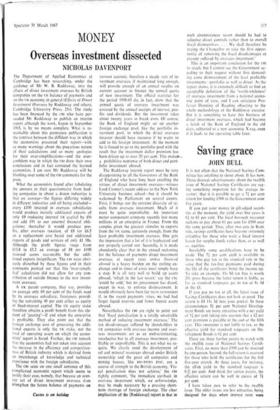Saving grace
JOHN BULL
It is not often that the National Savings Com- mittee has anything to shout about. It has now.
Those discreet advertisements about the twelfth issue of National Savings Certificates are say- ing something important for the average in- vestor: that it is possible to get a 71 per cent return for lending £500 to the Government over five years.
If you put your money in gilt-edged securi- ties at the moment, the yield over five years is 63 to 63 per cent. The local borough treasurer reckons to pay about 63 per cent for £500 over the same period. Thus, after two cuts in Bank rate, savings certificates have become extremely attractive for those who want a fixed interest haven for surplus funds rather than, or as well as, equities.
Inevitably some qualifications have to be made. The 73 per cent yield is available to
those who pay tax at the standard rate in the sense that the tax-free premiums paid during the life of the certificates bring the income up.
To take an example, 1 Is 9d tax free is worth 20s gross because the latter return is liable, as far as standard taxpayers go, to tax at 8s 3d in the £1.
If you pay no tax at all, the latest issue of Savings Certificates does not look so good. The return is £4 Its 3d into your pocket. In these circumstances 53 per cent National Develop- ment Bonds are more attractive with a net yield of 51 per cent taking into account that a £2 per cent premium is payable at the end of the fifth year. This sweetener is not liable to tax, so the effective yield for standard taxpayers on De- velopment Bonds is 6.1 per cent.
There are three further points to watch with the twelfth issue of National Savings Certifi- cates. First, no more than £500 can be invested by one person. Second, the full return is reserved for those who hold the certificates for the full five-year stretch. At three years, for instance, the all-in yield to the standard taxpayer is 6p, per cent. And third, for surtax payers, the effective return can be well in excess of 73 per cent.
I have taken care to refer to the twelfth issue. The older issues are less attractive, being designed for days when interest rates were lower. There are, in fact, people still holding the first issue, dated 1916. And they are earning a miserly If per cent tax free on their money.
The other main savings medium with a con- spicuously high return by today's standards is the building society movement. The 41 per cent rate which the societies offer is equivalent to 71 per cent grossed up for tax at 8s 3d in the £1. But apart from the fact that this return is half a point lower than that on Savings Cer- tificates, there is a second disadvantage. It can- not be expected that the movement will hold its 41 per cent rate for very long. Whereas the return on Savings Certificates is fixed, that on building society investments is not.
I guess that the building societies will bring their rate down to 4 per cent or lower during the next three months. At the moment funds are flowing in well, which provides plenty of elbow room on the lending side. But the mar- gin could soon become embarrassing. There is already the spectacle of building societies on- lending their funds in the local authority mar- ket. They are not in business to aot as money jobbers. And the home loan rate is so much in the public gaze that unwelcome publicity would attend any attempt to hold it up for a minute longer than necessary.
In this case, also, tax considerations must turn the non-taxpayer away. The building societies return is 4+ per cent tax-free. As with the other examples discussed here, the tax notionally paid cannot be reclaimed.
Where building societies have the edge over Savings Certificates is that the upper limit is £5,000 rather than £500. But the outstanding advantage which the movement offers to savers at the moment is its high short-term rate. You have got to hold Savings Certificates and National Development Bonds for a year be- fore any return accrues. Building societies credit you with interest for every day the funds are invested. Thus the effective 7+- per cent rate for standard taxpayers over; say, one month compares with 4 per cent on bank deposits, 6 per cent with the local authorities and 5+ per cent on money in the Post Office investment account.
It will be interesting to see what the Chan- cellor does or does not do for small savings in the Budget. At 31 December 1966 there was £8,333 million invested in National Savings, a year earlier the comparable figure was £8,363 million. That is the first drop for a very long time.































 Previous page
Previous page